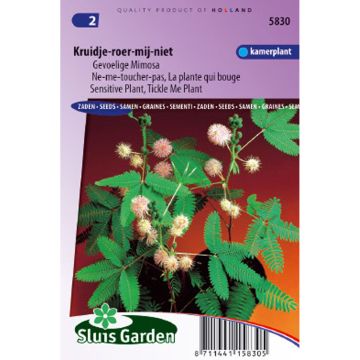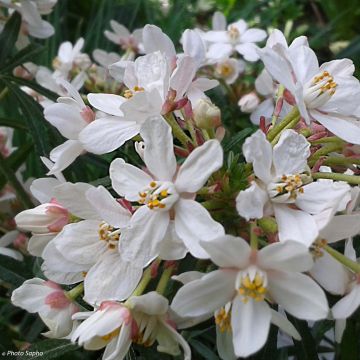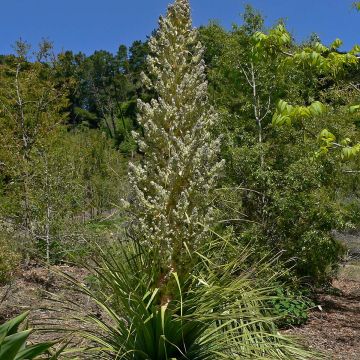

Acacia retinodes


Acacia retinodes
Acacia retinodes
Acacia retinodes
Swamp Wattle, Water Wattle, Wirilda, everblooming acacia
After a week of waiting due to the delivery driver, I finally received my order, after some concerns about the condition, just a little water and it's back on track.
Christian , 17/12/2024
This plant carries a 24 months recovery warranty
More information
We guarantee the quality of our plants for a full growing cycle, and will replace at our expense any plant that fails to recover under normal climatic and planting conditions.
From €5.90 for pickup delivery and €6.90 for home delivery
Express home delivery from €8.90.
Delivery to Corse prohibited: UE law prohibits the import of this plant from mainland France to Corse as part of the fight against Xylella fastidiosa. Please accept our sincere apologies.
More information
Does this plant fit my garden?
Set up your Plantfit profile →
Description
The Acacia retinodes, commonly known as the Four-Seasons Mimosa, should not be confused with the tree we call acacia, which is part of the Robinia botany genus. It is a large evergreen bush that flowers several times in the year, with a predominance from May to November. It produces numerous clusters bearing small characteristic flowers, evoking tiny yellow pom-poms, with a unique fragrance, highly prized in floral art. Its light foliage consists of bright green flattened, very thin and elongated petioles. This mimosa is not very hardy, but it tolerates poor and calcareous soils well, drought, and does not produce suckers. It will form a magnificent specimen in a large pot, to be stored in the winter in cold regionsor in the open ground in mild climates.
The Acacia retinodes is a bush native to Australia, belonging to the fabaceae family, just like alfalfa and lupins. This small tree or large bush has a rounded and compact habit, reaching 4 m (13 ft 1 in) in all directions at adult age. Its growth is quite fast. The bark, of a reddish brown, cracks as it ages. Its flowering is irregular from January to December, but particularly abundant from May to November. Its small round flowers are bright yellow stamen glomerules and are gathered on axillary racemes. Their scent is recognisable among all: an initial very fresh herb fragrance gives way to a divine honey scent, a powdery fragrance. Its foliage consists of flattened petioles, which we call phyllodia, resembling long and lanceolate green leaves. The plant easily self-sows in acidic soil and often serves as a graft for other species and varieties thanks to its good tolerance of calcareous soil. Its hardiness does not exceed -6°C (21.2 °F), but its resistance to summer drought is excellent.
When planted in open ground in mild climates, the Four-Seasons Mimosa can be placed as a stand-alone, in a hedge or row, or as a plant screen because of its capacity to conceal. It can be combined with other exotic-looking frost-sensitive bushes such as the Caesalpinia gilliesii, the Jacaranda mimosifolia (Blue Flamboyant), the Sesbania punicea, the escallonias, or the Coleonema album. It can be grown in a pot provided that it is protected from winter frosts in a greenhouse or a very slightly heated veranda.
Report an error about the product description
Acacia retinodes in pictures






Plant habit
Flowering
Foliage
Botanical data
Acacia
retinodes
Fabaceae
Swamp Wattle, Water Wattle, Wirilda, everblooming acacia
Australia
Other Acacia - Wattle
Planting and care
The Acacia retinodes is preferably planted in the spring, in March or April, in a very sunny location sheltered from strong winds; autumn planting is limited to mild climates. Due to its superficial roots,it is best to stake the all-seasons mimosa at the time of planting to keep it upright and allow its roots to establish. This bush is not fussy about soil types provided that they are fairly well-drained. As it tolerates drought well, watering is not necessary when grown in open ground. Although optional, light pruning is advised, especially if the tree is slightly exposed to the wind: after the bulk of the flowering, in December, shorten the branches that have flowered by about half their length. This operation will prevents the formation of pods that unnecessarily exhaust the plant. Pruning can also be carried out in Spring to remove branches that have suffered from the cold and rebalance the habit of the bush. As mimosa are averse to the cold, it is advisable to spread a thick layer of mulch at their base and cover them with a winter cloak as soon as temperatures drop close to 0°C.
If growing a Mimosa in a pot, repot it into a larger container every two years, in the spring. Water from time to time, the root ball should not dry out completely. In cold regions, it should be wintered in a bright and cool but frost-free place.
Planting period
Intended location
Care
-
, onOrder confirmed
Reply from on Promesse de fleurs
Evergreen shrubs
Haven't found what you were looking for?
Hardiness is the lowest winter temperature a plant can endure without suffering serious damage or even dying. However, hardiness is affected by location (a sheltered area, such as a patio), protection (winter cover) and soil type (hardiness is improved by well-drained soil).

Photo Sharing Terms & Conditions
In order to encourage gardeners to interact and share their experiences, Promesse de fleurs offers various media enabling content to be uploaded onto its Site - in particular via the ‘Photo sharing’ module.
The User agrees to refrain from:
- Posting any content that is illegal, prejudicial, insulting, racist, inciteful to hatred, revisionist, contrary to public decency, that infringes on privacy or on the privacy rights of third parties, in particular the publicity rights of persons and goods, intellectual property rights, or the right to privacy.
- Submitting content on behalf of a third party;
- Impersonate the identity of a third party and/or publish any personal information about a third party;
In general, the User undertakes to refrain from any unethical behaviour.
All Content (in particular text, comments, files, images, photos, videos, creative works, etc.), which may be subject to property or intellectual property rights, image or other private rights, shall remain the property of the User, subject to the limited rights granted by the terms of the licence granted by Promesse de fleurs as stated below. Users are at liberty to publish or not to publish such Content on the Site, notably via the ‘Photo Sharing’ facility, and accept that this Content shall be made public and freely accessible, notably on the Internet.
Users further acknowledge, undertake to have ,and guarantee that they hold all necessary rights and permissions to publish such material on the Site, in particular with regard to the legislation in force pertaining to any privacy, property, intellectual property, image, or contractual rights, or rights of any other nature. By publishing such Content on the Site, Users acknowledge accepting full liability as publishers of the Content within the meaning of the law, and grant Promesse de fleurs, free of charge, an inclusive, worldwide licence for the said Content for the entire duration of its publication, including all reproduction, representation, up/downloading, displaying, performing, transmission, and storage rights.
Users also grant permission for their name to be linked to the Content and accept that this link may not always be made available.
By engaging in posting material, Users consent to their Content becoming automatically accessible on the Internet, in particular on other sites and/or blogs and/or web pages of the Promesse de fleurs site, including in particular social pages and the Promesse de fleurs catalogue.
Users may secure the removal of entrusted content free of charge by issuing a simple request via our contact form.
The flowering period indicated on our website applies to countries and regions located in USDA zone 8 (France, the United Kingdom, Ireland, the Netherlands, etc.)
It will vary according to where you live:
- In zones 9 to 10 (Italy, Spain, Greece, etc.), flowering will occur about 2 to 4 weeks earlier.
- In zones 6 to 7 (Germany, Poland, Slovenia, and lower mountainous regions), flowering will be delayed by 2 to 3 weeks.
- In zone 5 (Central Europe, Scandinavia), blooming will be delayed by 3 to 5 weeks.
In temperate climates, pruning of spring-flowering shrubs (forsythia, spireas, etc.) should be done just after flowering.
Pruning of summer-flowering shrubs (Indian Lilac, Perovskia, etc.) can be done in winter or spring.
In cold regions as well as with frost-sensitive plants, avoid pruning too early when severe frosts may still occur.
The planting period indicated on our website applies to countries and regions located in USDA zone 8 (France, United Kingdom, Ireland, Netherlands).
It will vary according to where you live:
- In Mediterranean zones (Marseille, Madrid, Milan, etc.), autumn and winter are the best planting periods.
- In continental zones (Strasbourg, Munich, Vienna, etc.), delay planting by 2 to 3 weeks in spring and bring it forward by 2 to 4 weeks in autumn.
- In mountainous regions (the Alps, Pyrenees, Carpathians, etc.), it is best to plant in late spring (May-June) or late summer (August-September).
The harvesting period indicated on our website applies to countries and regions in USDA zone 8 (France, England, Ireland, the Netherlands).
In colder areas (Scandinavia, Poland, Austria...) fruit and vegetable harvests are likely to be delayed by 3-4 weeks.
In warmer areas (Italy, Spain, Greece, etc.), harvesting will probably take place earlier, depending on weather conditions.
The sowing periods indicated on our website apply to countries and regions within USDA Zone 8 (France, UK, Ireland, Netherlands).
In colder areas (Scandinavia, Poland, Austria...), delay any outdoor sowing by 3-4 weeks, or sow under glass.
In warmer climes (Italy, Spain, Greece, etc.), bring outdoor sowing forward by a few weeks.















































